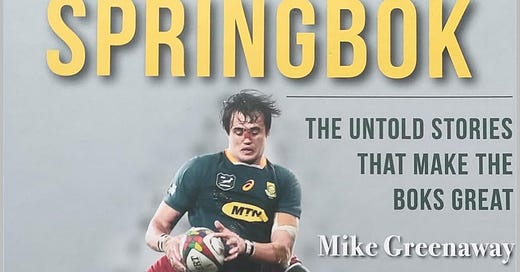The Fireside Springbok by Mike Greenaway, published by Pinetown Printers, KwaZulu Natal, South Africa. (E-book edition $NZ11.61 Amazon.com).
New Zealanders enjoy talking about their rugby legacy, their great players, characters, and controversies, but they should never think they are any different from rugby fans in other parts of the world.
Especially South Africa.
The Springboks, New Zealand's greatest rivals, have a legacy and remembering that enriches the competition between the two countries.
Respected South African rugby journalist Mike Greenaway has produced a compelling reader, The Fireside Springbok, that is easily accessible in e-book form to bring New Zealanders some of the pillars of the Springbok legacy to life.
As Greenaway says in his introduction, exposure to past deeds came from research that rewarded him with fascinating stories that emerged the deeper he dug.
There are fewer more rewarding moments when researching than dusting off long-forgotten or overlooked texts that help contextualise the subject while also ensuring events are recalled accurately and not, as often occurs, by failing memories.
The result is a fascinating publication, with stories that are intriguing in their own write (the pun is deliberate) but also leave the reader wanting more.
Characters from the years before contact with New Zealand began in 1919 during the visit of the NZ Army team on their way home from the First World War set the scene.
The first is Springbok captain Fairy Heatlie, a player so good that he captained Western Province in the Currie Cup at 18 in 1890. A year later, he played in South Africa's first Test at home against the British Isles.
Four years later, another British team toured, winning the first three of the four-Test series, before Heatlie was made captain for the fourth Test and became the country's first winning captain.
In a fascinating parallel to the All Blacks' first captain, Tom Ellison, Heatlie was responsible for South Africa's choice of colour, the green they still wear. The colours were those of his Old Diocesans club in Cape Town, and the green is regarded as the colour of hope.
Bad luck with his finances saw Heatlie skip the country for Argentina when he was suspected of embezzlement. He rehabilitated himself and his finances in the sugar cane industry there, repaying his debts while helping establish rugby in his new country and winning a Test cap for Argentina against Britain.
Heatlie returned to South Africa, where a legendary figure of the game's early years, Oubaas Markotter, said in 1955, "In 60 years of the Springboks, Fairy Heatlie is the greatest forward South Africa produced."
Another notable character was Billy Millar, the captain of the 1912/13 tour to Britain, Ireland, and France. When it comes to players having 'been in the wars, ' Millar fits the bill.
Having run away from home to join the British Army in the Anglo-Boer War, he was shot in his shoulder, narrowly avoiding amputation. Exercise was advised to build his strength back up, demonstrating what would become a character trait of determination; he walked so much that he became Western Province's 80km walking champion.
He also won the Cape Colony's amateur heavyweight championship. Selection in the Springbok team of 1906 to Britain followed, and then he led the side on the 1912/13 tour – one of the great South African sides.
Serving in the First World War, he suffered another arm injury, which also threatened amputation, only to survive and achieve a three handicap in golf. He became a Test referee in 1924 during the British Isles series in South Africa.
And so the characters through the years are covered with a fascinating story of Howard Watt, the last of the great 1937 team to die. His family moved to Chicago when he was 17, and as a cricketer, he concentrated on that game, playing for an Illinois XI against the touring Australian cricket team in 1932.
Watt bowled Don Bradman for four in the first innings and 13 in the second. When Watt returned to South Africa a year later, he was regarded as the country's fastest bowler, but he was a controversial omission from the South African team.
But the No8 did win selection for the 1937 tour.
The Springboks lost two games only on the tour, the first their opening game against New South Wales and the first Test against the All Blacks.
"We really stuffed up the selection for that game. We had picked up a number of injuries. In the second Test against the Wallabies, Danie Craven had played No8. For the opening Test against the All Blacks, it was decided that Danie should play flyhalf when Tony Harris was a far better bet."
The stories continue with players New Zealand rugby fans will appreciate, like, Boy Louw, Hennie Muller, Martin Pelser, Henry de Villiers, Dawie de Villiers, Frik du Preez, Andy MacDonald, Jan Ellis, Pieter-Steph du Toit and father Pieter du Toit, Joggie Jansen, Mannetjies Roux, Tommy Bedford, Morne du Plessis, Errol Tobias, Danie Gerber, James Small, Joost van der Westhuizen, Mark Andrews, Os du Randt, Andre Venter, Andre Joubert, Breyton Paulse, Butch James et al discussed and profiled.
As another Rugby Championship nears, it is worth remembering the back story of the South African game, its highs and lows, is just as intriguing as the All Blacks' story, and Mike Greenaway has captured it well.



